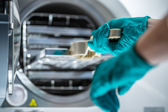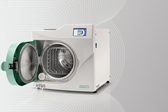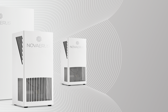Categories
Most Recent
Novaerus Air Disinfection - first-line defence against the airborne transmission of infection
18th Jul 2023 in Animal HealthAir quality is a vital consideration for both human and animal health. Since the pandemic, there has been a heightened focus on airborne infection and the ways in which it can spread. In a high-risk environment like veterinary practices, the veterinary team must be diligent in reducing the risk of infection via the airway and maximise measures to ensure patients, their owners and staff are adequately protected.
One of the ways this can be facilitated is through the use of an air disinfection unit, which is designed to provide protection against many airborne microorganisms, in addition to other substances and allergens. What do you need to know about air disinfection units?
How can infection spread through the air?
As the pandemic demonstrated, airborne infection can spread rapidly, causing major outbreaks of illness. Even in environments where infection control protocols should always be stringent, such as veterinary facilities and hospitals, the risks to humans were and still are high. Research shows that the spread of infectious diseases has been associated with buildings and with time spent indoors.[i] Within veterinary clinics, there are unique microorganisms that can be transferred from animals to humans, putting staff, other animals and other human personnel at risk. Strict protocols are therefore paramount to ensure the air in the clinic is clean and safe.
Infection can spread through the airways via respiratory droplets:[ii] smaller droplets, or aerosols, are postulated as less than 5μm (micrometres). They can remain suspended in the airflow for long periods of time, and are more likely to be inhaled into the lungs, potentially causing infection in the lower respiratory tract, while the larger droplets catch in the upper airways.[iii] Animals can harbour microbial pathogens that can be transmitted to a human host, which range from viruses to bacteria, parasites, fungi and prions.[iv] As you know, diseases such as parvovirus and kennel cough can be spread through airborne droplets, along with many other diseases that can be transmitted to both other animals and to humans.
Indoor air can also harbour other pollutants that pose risks to staff and patients. Volatile organic compounds (VOCs) are gaseous pollutants that can be released from various sources, such as: varnishes, adhesives, flooring, carpet, cleaners, disinfectants, air fresheners and furniture.[v] VOCs can irritate the eyes, nose and throat. Also, with many human personnel entering and leaving the clinic, there is always the risk of spreading common respiratory infections such as the common cold, coronavirus, influenza and whooping cough.[vi] This is especially so if general hand hygiene is not followed, such as sneezing or coughing into the hands, and immediately not washing and/or using hand sanitiser.
Air disinfection – what you need to know
Ventilation and filtration are cited as methods of keeping the airflow clean and safe to breathe. Ventilation is an important factor in the design of a veterinary practice, with regards to humidity and odour control, as well as ensuring that the airflow is fresh and clean. Keeping the air entirely free from airborne pathogens is not always possible: there may be multiple sources of potential infection at any given time or place within the practice. Plus, with owners coming and going, alongside patients being treated and potentially harbouring infectious pathogens, this can influence the microbe concentration in the airflow. As such, ventilation must be robust in order to support the fluctuations of contamination in the air. However, good ventilation may not always be achievable, which may be due to a poor architectural layout in the practice, for instance. As such, you might look into other methods of keeping patients, their owners and your team safe.
Plasma technology – the future of air disinfection?
Air disinfection units are a reliable way to keep the air quality at an acceptable level, and there are many different models available on the market, with various types of technologies. Plasma technology is an interesting development, and is used within several industries to much acclaim. Plasma consists of positive ions and negative electrons, and is often referred to as the ‘fourth state of matter’, following solids, liquids and gases.[vii] Around 99% of our universe is made of plasma,vii in addition to stars, auroras and also lightening. Among its many applications, research has demonstrated its efficacy against airborne infection.[viii] Units utilising plasma technology can provide protection for the veterinary clinic, with features designed for continuous air disinfection and odour control – the latter of which is another vital aspect you must consider when investing in an air disinfection unit. Plasma air disinfection systems are available in varying sizes, making them suitable should you wish to place one in your reception area, waiting room and/or staff room.
Some air disinfection units have further developed the capabilities of plasma technology, killing and deactivating harmful airborne microorganisms on contact. Such equipment is able to deactivate viruses, bacteria and fungi at a DNA level, ensuring that the viruses do not spread, and the bacterial/fungal spores do not reproduce. For instance, the patented NanoStrike technology used by Novaerus air disinfection units is tested and proven to deactivate airborne viruses, bacteria, mould spores and VOCs, in a sub-second timeframe. Eschmann offers the unique Novaerus technology to veterinary practices, providing 24/7 air protection whilst producing no harmful by-products. Novaerus units are also convenient and cost-effective to run as they do not require any maintenance or consumables such as filters or UV bulbs.
Breathe easy
Clean, safe air is vital to our good health and that of our animal patients. However, it has never before been so evident that air is the perfect medium for airborne infection to travel and infect. The veterinary clinic must be vigilant in protecting the workplace with high-quality, robust systems, designed to keep the air clean and safe to breathe.
[i] Allen, J.G. and Ibrahim, A.M. (2021). Indoor Air Changes and Potential Implications for SARS-CoV-2 Transmission. JAMA. [online] Available at: https://jamanetwork.com/journals/jama/fullarticle/2779062 [Accessed 25 May 2023].
[ii] GOV.UK. (2023). What infections are, how they are transmitted and those at higher risk of infection. [online] Available at: https://www.gov.uk/government/publications/health-protection-in-schools-and-other-childcare-facilities/what-infections-are-how-they-are-transmitted-and-those-at-higher-risk-of-infection [Accessed 25 May 2023].
[iii] Jayaweera, M., Perera, H., Gunawardana, B. and Manatunge, J. (2020). Transmission of COVID-19 virus by droplets and aerosols: A critical review on the unresolved dichotomy. Environmental Research, [online] 188(1), p.109819. Available at: https://www.ncbi.nlm.nih.gov/pmc/articles/PMC7293495/ [Accessed 25 May 2023].
[iv] Fong, I.W. (2017). Animals and Mechanisms of Disease Transmission. Emerging Zoonoses, [online] pp.15–38. Available at: https://www.ncbi.nlm.nih.gov/pmc/articles/PMC7120673/ [Accessed 25 May 2023].
[v] www.lung.org. (n.d.). Volatile Organic Compounds. [online] Available at: https://www.lung.org/clean-air/at-home/indoor-air-pollutants/volatile-organic-compounds#:~:text=Volatile%20organic%20compounds%2C%20or%20VOCs [Accessed 25 May 2023].
[vi] GOV.UK. (n.d.). What infections are, how they are transmitted and those at higher risk of infection. [online] Available at: https://www.gov.uk/government/publications/health-protection-in-schools-and-other-childcare-facilities/what-infections-are-how-they-are-transmitted-and-those-at-higher-risk-of-infection#:~:text=These%20can%20penetrate%20deep%20into [Accessed 26 May 2023].
[vii] Plasma Science and Fusion Center (2020). What is Plasma? | MIT Plasma Science and Fusion Center. [online] Mit.edu. Available at: https://www.psfc.mit.edu/vision/what_is_plasma [Accessed 26 May 2023].
[viii] Terrier, O., Essere, B., M. Yver, Barthelemy, M., M. Bouscambert-Duchamp, Kurtz, P., D. VanMechelen, Morfin, F., Geneviève Billaud, Ferraris, O., Lina, B., Rosa-Calatrava, M. and Moules, V. (2009). Cold oxygen plasma technology efficiency against different airborne respiratory viruses. 45(2), pp.119–124. doi:https://doi.org/10.1016/j.jcv.2009.03.017.









